Rheonics sensor installation: basic principles
Rheonics balanced torsional resonators enable the sensor to be installed in any orientation.
Rheonics SR-Sensors can be installed in any position as long as the sensing element of the sensor is inmersed completely. Balanced torsional resonators will not be affected by the external world and will not transmit vibration to its surroundings.
With that statement however, we do find users asking for more guidance on installation. Experiencies in different applications have also enabled us to collect enough data to recommed mounting decisions for particular situations. This page aims to explain how Rheonics SR- sensors behave with the most common fluid types and give installation recommendations for each case.
Rheonics offers two types of SR probes, the SRV inline viscometer and SRD inline density and viscosity meter. Learn more about each sensor on the Rheonics product page and support articles here.
Before describing the performances of the SRV and SRD in different types of fluids, two categories of fluids must be mentioned that are encountered whenever viscosity measurements come into play – these are Newtonian and non-Newtonian fluids. Rheonics has a lot of information that defines each of these fluid types on the web, like this Blog.
For a Newtonian fluid, viscosity does not change when a force is applied, so static and moving conditions show the same viscosity readings. Other conditions may change the viscosity of these fluids, like differences in temperature.
For a non-Newtonian fluid, measured viscosity depends on the shear rate with which the measurement is conducted. There are many types of non-Newtonian fluids but what they have in common is that their viscosities can’t be associated with a particular value for different measuring instruments, since often, the shear rate at which the measurement is done differ between different measuring technologies.
Density measurements, on the other hand, shouldn’t be affected by Newtonian or non-Newtonian behavior of fluids.
Majority of fluids encountered in industrial processes are non-Newtonian so, when using an inline viscometer, the operational conditions should be considered. Rheonics ensures the repeatability of readings at the same conditions which is ultimately the most important factor in process control.
Now we can review different kinds of fluids and conditions, and give some considerations and recommendations for them. The scenarios covered in this article are:
- Static conditions
- Moving fluids
- Bubbly flows
- Solid particles
- Deposits
- Fluids with a yield stress
We will define static conditions as no flow in the fluid. This is usually how most laboratory instruments operate.
For Newtonian fluids, viscosity will be the same if measured in a beaker, where fluid is static, or inline in a process, where it could be moving at varying rates.
For non-Newtonian fluids, viscosity measurements of static fluid will be different than measurements of the same fluid under different flow rates. This is due to different imposed shear rates from flow. as well as structure disruption due to flow of a structured fluid.
If a static test is required, the user should:
- Immerse the sensor enough so the sensing element is in contact with the fluid (see Figure 1).
- Consider a clearance of 5mm from the tip to obstructions for the SRV and 12mm for the SRD.
- Clamp the sensor so it is firmly fixed avoiding any motion of the probe in the fluid.
- If water measurement is required, the vessel should be pressurized to avoid any bubbles in the fluid. Bubbles settling on the sensing element should be always avoided as it will disrupt the measurement.
- Recommended test/reference fluids are alcohols, solvents, or oils.
- Consider that high-temperature tests will require a temperature control chamber.
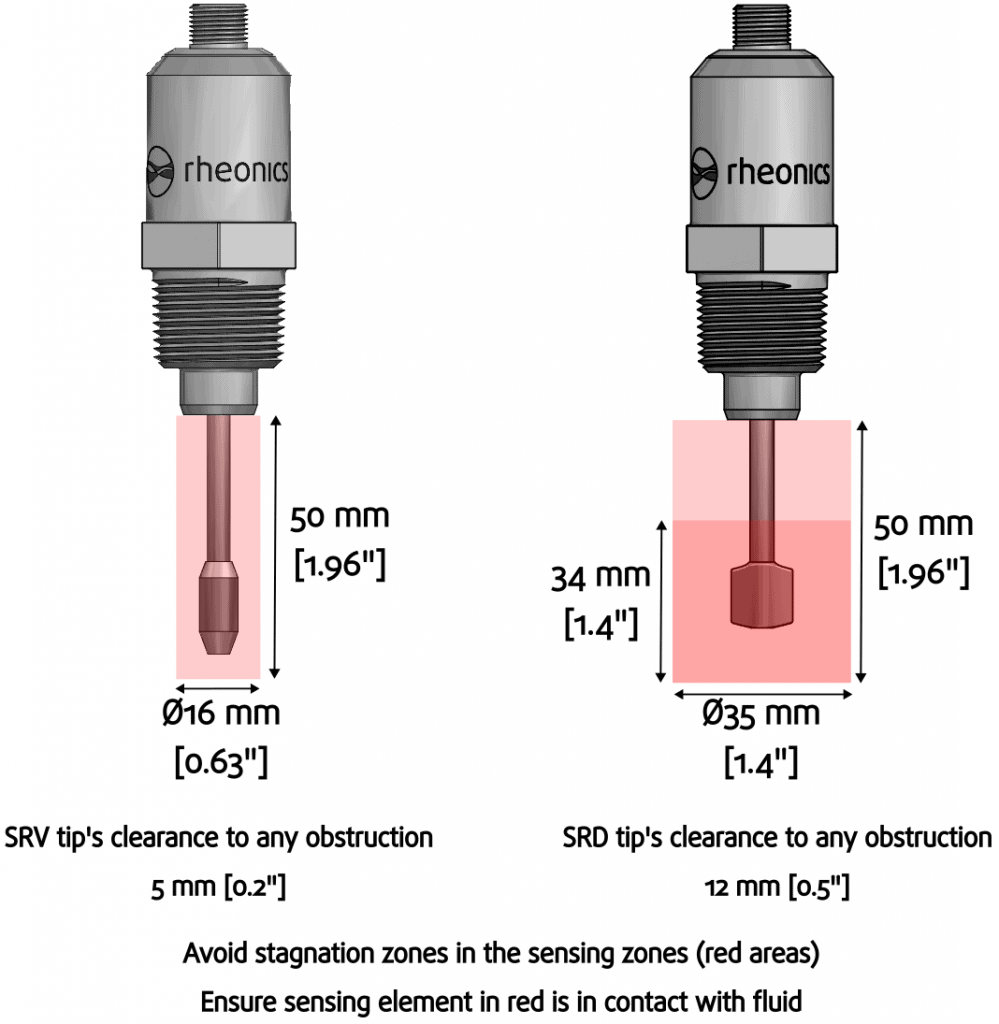
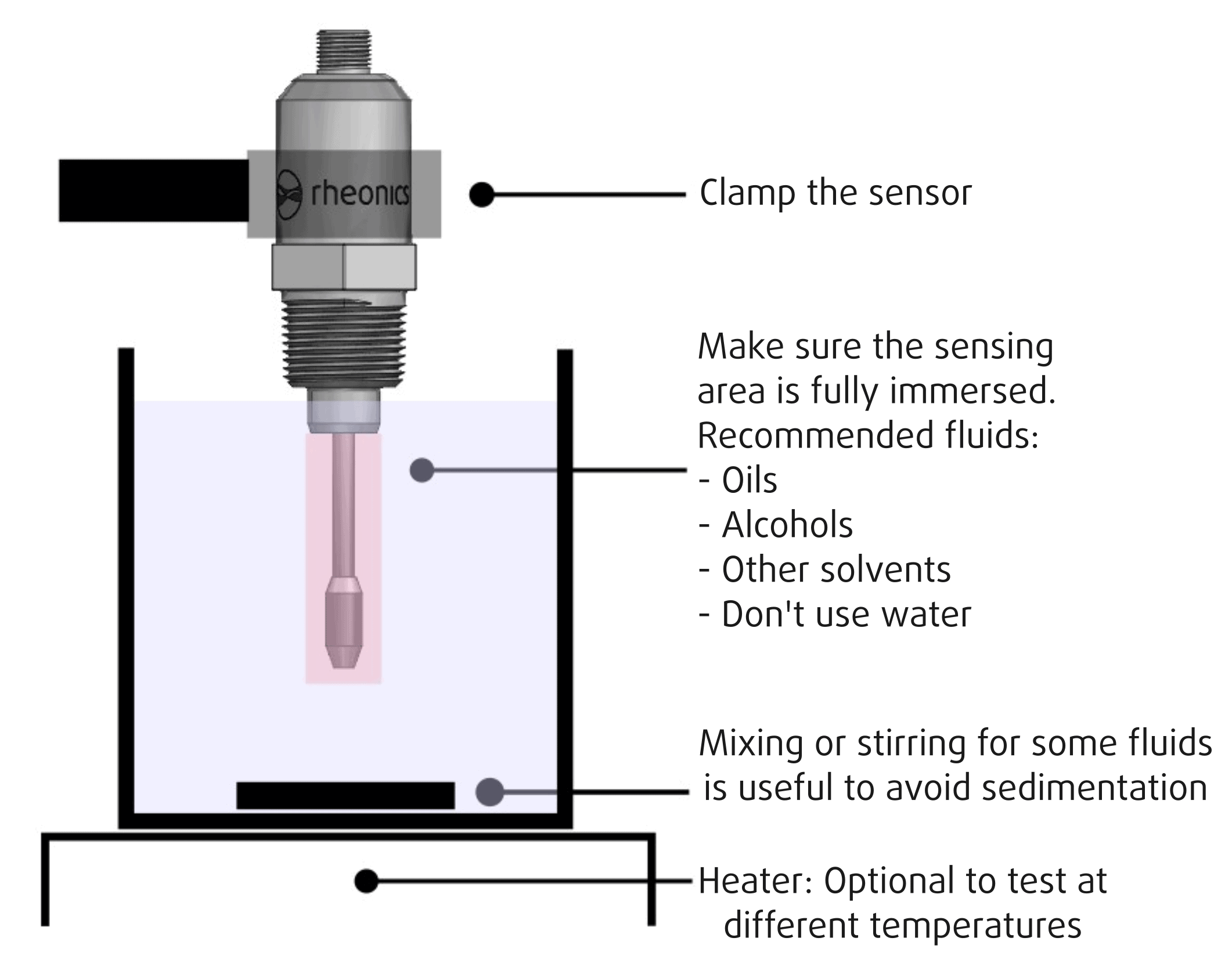
In this case, the sensor is installed in a process line or mixing tank. The SRV and SRD are unaffected by possible vibrations in the installation, but flow rate plays a role in viscosity measurements for most fluids.
| General Points | Installation Instructions | |
|---|---|---|
| Newtonian fluids | Readings are unaffected and will be the same for any flow rate or at any fluid state (laminar or turbulent). | Avoid stagnation zones. |
| Non-Newtonian fluids | - Readings will vary with flow rate and may not match other measuring technologies (e.g. zhan cups). Rheonics SR-sensors ensure the repeatability and reproducibility of readings so the client should use the historical data to study and create a process/batch/recipe identity. - Density is not affected. | - Exposition of the sensor to a good uniform flow rate is needed. If a short sensor can’t ensure this, consider a long insertion sensor. - Stagnation zones must be avoided. - When replacing a viscosity sensor (inline or lab), don’t expect the same viscosities with SR-Sensors. Sensing technologies are different and viscosity readings vary. |

Fluids with entrained air or bubbles are frequent. SRV and SRD behave differently towards bubbles, so let’s study them separately.
| General points | Installation instructions | |
|---|---|---|
| SRV viscometer | - The SRV measures what is in contact with its wetted surface. At static conditions, bubbles will concentrate on the sensor’s surface thus affecting the readings, usually with increments in viscosity even though the fluid is not changing. This is due to the bubbles creating additional damping on the resonator surface. In moving conditions, bubbles will be sheared off. SRV will mostly sense the fluid and measurements are not affected. Bubble percentage and size generally do not affect measurements in a moving fluid. | - Avoid stagnation zones to eliminate the possibility of bubbles accumulating around the sensing element. sensor. - Keep the sensing element fully submerged. - High points in the pipeline may have accumulated air, avoid installation in those zones. |
| SRD density and viscosity mete | SRD induces a flow while vibrating torsionally, this is needed to measure density. Bubbles affect then the density and viscosity readings for the SRD. In most cases, viscosity increases and density decreases with bubbles. The variation depends on the bubbles percentage, size and movement | - Try to install the SRD where there are no, or minimal bubbles. Pressurizing the line is useful to remove bubbles. - Filters can be used in sensor electronics to reduce the noise in measurement due to bubbles in SRD’s readings. - SRD has successfully been used in bubbly fluids, so tests are always worth doing. |
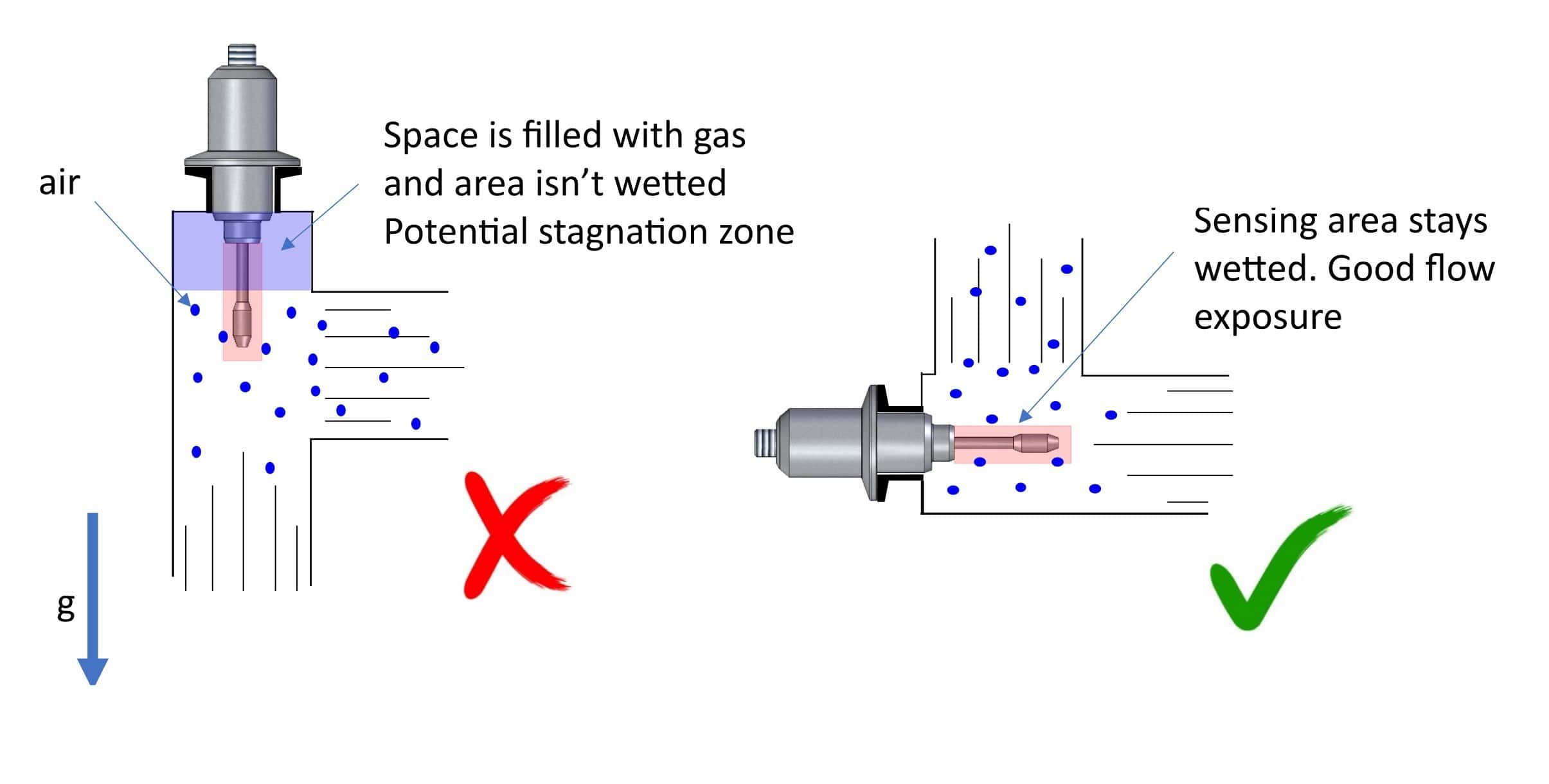
The behavior of SR sensors in fluids with solid particles will depend on the size of these particles.
| General point | Installation instructions | |
|---|---|---|
| Particles of micrometers scale Example: Inks and slurries | This is below the fluid-length scale that the sensor can measure. The SRV or SRD sees such suspension as a homogeneous fluid, which has a viscosity and a density. For inks, the viscosity is primarily of interest, so the SRV is typically used. For slurries, both viscosity and density may be important, so the SRD can be used. | - From an installation perspective, they are very similar to non-Newtonian fluids. - It is crucial to avoid any stagnation zones. |
| Large particles (rice corn size) | - These particles are much larger than the measuring length scale of the sensor, so they will interact with the sensor differently. - When a particle hits the sensing element it creates a large disturbance, interrupting a measurement. This interruption can lead to large errors, creating outliers in the measurement. These errors are sporadic and dependent on how frequently the sensor is hit by the particles. - The SRD tends to react more strongly to those impacts than the SRV. - If particles are too big and have a considerable mass, and hits in the sensor probe are constant, constant readings may not be possible and the sensor can be affected in the long run. | - Place the sensor in an area where large particles are not present or less frequent. - Consider installing the sensor so it is hit by the flow axially. Long insertion sensors can be convenient. - Consider the density of the particles and identify where they may concentrate or create deposits at the bottom or top of the pipe, elbows, etc. Do not place the sensing element in those identified zones. - The use of protective sleeve accessories is not recommended except in situations where the particles are large and have a potential to damage the sensing element. Care should be taken to ensure that the protective sleeve does not cause plugging of the sensing element. Where possible avoid protective sleeve. In cases where you must, then visit the accessories page to select a suitable one: Accessories » rheonics. |
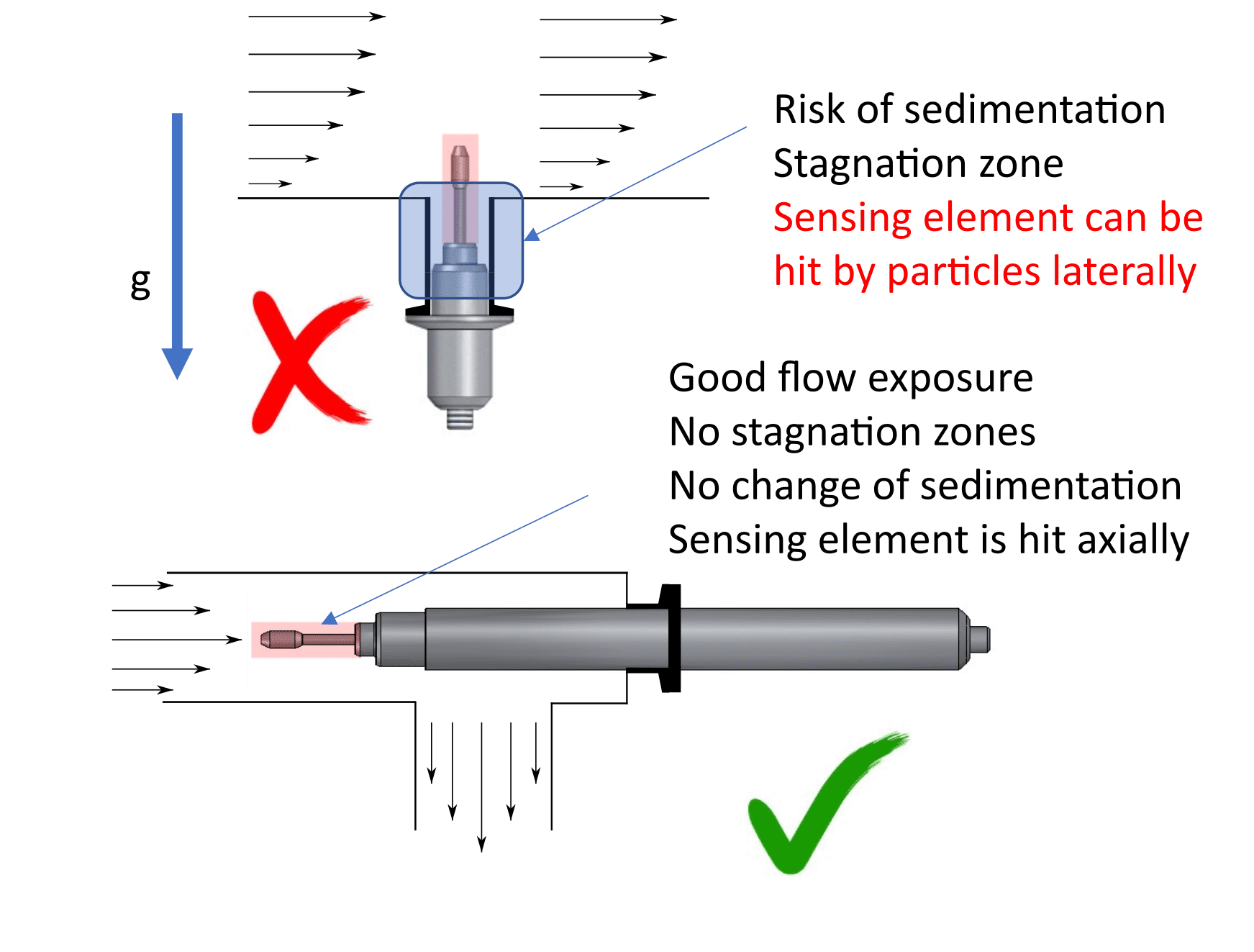
In biological or chemical processes, deposits may form at the inner wall of pipes or reactors, these are layers or coatings on surfaces. If this is the case, there is a good chance that the same will occur on the sensing element. Deposits on the sensing element can affect the readings under some circumstances.
A good indicator is the fluid length scale, if the deposit is of similar or larger thickness than the fluid length scale it is likely going to interfere with the measurement. In case it is significantly below, the measurements won’t be affected. This is dependent on the type of the deposit, the thickness of the deposit as well as the viscosity of the fluid.
The SRV is capable of detecting and even quantifying the amount of deposit on the sensing element. Thus, it can be monitored, how the deposit builds up over time, and if it has been removed during the cleaning process.
The SRD cannot detect deposits. In case one is present, it may distort both the viscosity and density reading. The only way to check if it is clean is visually, or when it is dry in the air. Deposits in the SRD then need to be removed with proper cleaning. The client should define how often the sensor should be cleaned since fouling or buildup depends on the fluid and installation. Follow this article on how to clean the sensor probe.
Long insertion sensors with appropiate insertion length are an alternative to avoid stagnation zones or deposits on inner walls. This allows the sensing element to clear the stagnation zone and be in the fluid that is of interest for measurement. Review SRV long insertion and SRD long insertion articles.
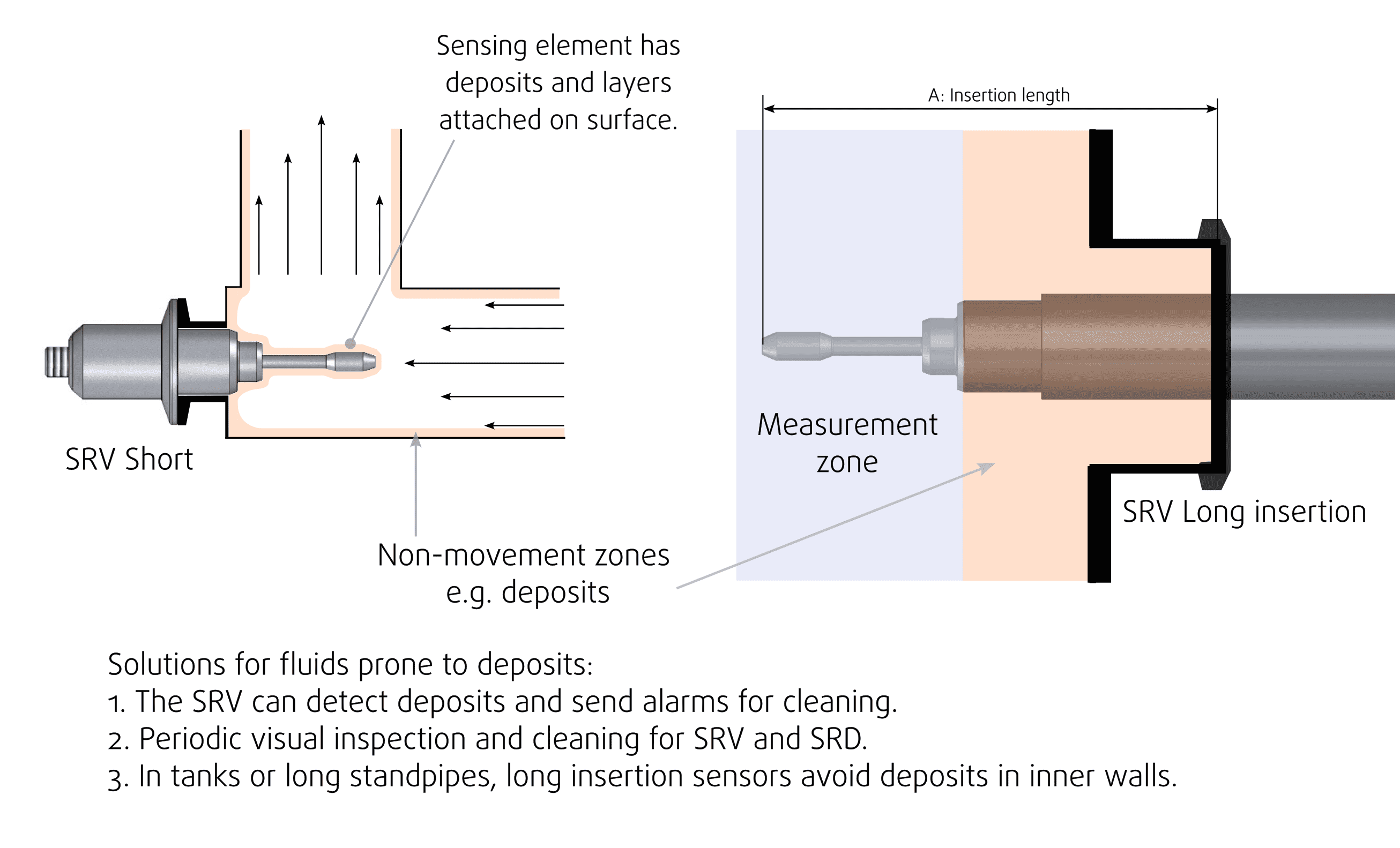
A fluid with yield stress is a type of non-Newtonian fluid. A fluid with yield stress is a fluid that requires a certain amount of shear to flow. Well-known examples are Ketchup and paint. For both fluids, yield stress is key for their final application and so this is a desired property for some fluids.
| General points | Installation instructions | |
|---|---|---|
| Fluids with yield stress | - The SRV and SRD torsional movement is not enough to shear off a fluid with yield stress. - Viscosity readings for a fluid with yield stress can vary between its static and moving conditions. The difference can be considerably big, it can be anywhere from a few percent, up to several hundred times the viscosity. - Installation is key for stable, repeatable and reproducible measurements. | - A regime must be defined (static or moving conditions), preference for moving conditions. - The fluid must be moving within the entire sensing area. - Avoid potential stagnation zones even small ones at the base of the sensing area. - Preferable installation is when the sensing element is directly exposed to the flow, parallel to the sensing element, as shown in the figure below. It is important to insert the sensor as far into the pipe as possible, beyond where the flow exits the T-piece, so a long insertion sensor is preferred. |
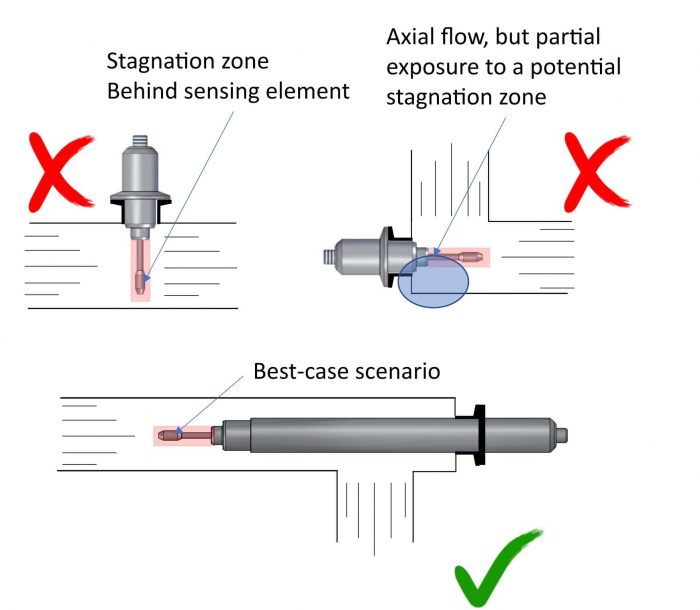
Sensor Technology, Working principle and Applications
Installation Overview
Process Connections
